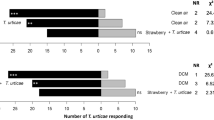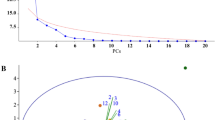Abstract
Emission rates of volatile organic compounds (VOCs) from Pirus malus L. subsp. mitis (Wallr.) var. Golden Delicious and var. Starking attacked by the phytophagous mite Panonychus ulmi Koch, and their attractiveness to the predatory mites Amblyseius andersoni Chant and Amblyseius californicus McGregor, were studied during three years. A large variability was found in the emission of individual VOCs depending on the infestation, the apple tree variety and the date. There were larger total VOC emission rates and larger total VOC leaf concentrations in apple trees attacked by phytophagous mites, especially in the var. Starking. In infested trees of this variety, there were also more predatory mites. An olfactometer assay showed that predatory mites preferentially chose branches infested by Panonychus ulmi (85% went to infested branches vs 15% to uninfested control branches) indicating that volatiles may be used as cues to find their prey.
Similar content being viewed by others
References
Alborn, H.T., Turlings, T.C.J., Jones, T.H., Stenhagen, G., Loughrin, J.H. and Tumlinson, J.H. 1997. An elicitor of plant volatiles from beet armyworm oral secretion. Science 276: 945-949.
Bruin, J., Sabelis, M.W. and Dicke, M. 1995. Do plants tap SOS signals from their infested neighbours? Trends Ecol. Evol. 4: 167-170.
Croft, B.A. and Slone, D.H. 1997. Equilibrium densities of European red mite (Acari: Tetranychidae) after exposure to three levels of predaceous mite diversity on apple. Environ. Entomol. 2: 391-399.
Dicke, M. 1988. Prey preference of the phytoseiid mite Typhlodromus pyri. I. Response to volatile kairomones. Exp. Appl. Acarol. 3: 1-13.
Dicke, M., Sabelis, M.W., Takabayashi, J., Bruin, J. and Posthumus, M.A. 1990. Plant strategies of manipulating predator-prey interactions through allelochemicals: prospects for application in pest control. J. Chem. Ecol. 11: 3091-3118.
Koveos, D.S., Kouloussis, N.A. and Broufas, G. D. 1995. Olfactory responses of the predatory mite Amblyseius andersoni Chant (Acari, Phytoseiidae) to bean plants infested by the spider mite Tetranychus urticae Koch (Acari, Tetranychidae). J. Appl. Entomol. 9: 615-619.
Langenheim, J.H. 1994. Higher plant terpenoids: A phytocentric overview of their ecological roles. J. Chem. Ecol. 6: 1223-1280.
Llusià, J., Estiarte, M. and Peñuelas, J. 1997. Terpenoids and plant communication, Butll. Inst. Cat. Hist. Nat. 64: 125-133.
Monetti, L.N. and Fernandez, N.A. 1996. Differences in European red mite infestation (Panonychus ulmi) in three apple tree varieties of a sprayed apple orchard. Acarologia 3: 181-188.
Pallini, A., Janssen, A. and Sabelis, M.W. 1997. Odour-mediated responses of phytophagous mites to conspecific and heterospecific competitors. Oecologia 110: 179-185.
Peñuelas, J., Llusià, J. and Estiarte, M. 1995. Terpenoids: A plant language. Trends Ecol. Evol. 7, 289.
Peñuelas, J. and Llusià, J. 1999. Seasonal emission of monoterpenes by the Mediterranean tree Quercus ilex in field conditions: Relations with photosynthetic rates, temperature and volatility. Phys. Plantarum 105: 641-647.
Röse, U.S.R., Manukian, A., Heath, R.R. and Tumlinson, H. 1996. Volatile semiochemicals released from undamaged cotton leaves. Plant Physiol. 111: 487-495.
Sabelis, M.W., Afman, B.P. and Slim, P.J. 1984. Location of distant spider mite colonies by Phytoseiulus persimilis: location and extraction of kairomone. In: Proceedings of the 6th International Congress of Acarology, Edinburgh, U.K., Vol. 1, pp. 431-446. Ellis Horwood, Chichester.
Stanyard, M.J., Foster, R.E. and Gibb T.J. 1997. Effects of orchard ground cover and mite management options on the population dynamics of European red mite (Acari: Tetranychidae) and Amblyseius fallacis (Acari: Phytoseiidae) in apple. J. Econ. Entomol. 2: 595-603.
Steinberg, S. and Cohen, M. 1992. Biological control of the two-spotted spider mite (Tetranychus urticae) in apple orchards by inundative releases of the predatory mite Phytoseiulus persimilis. In: Non-chemical approaches to crop protection in horticulture, Wellesbourne (UK), Vol. 20, pp. 37-44. A feasibility study, Conference proceeding.
Takabayashi, J. and Dicke, M. 1993. Volatile allelochemicals that mediate interactions in a tritrophic system consisting of predatory mites, spider mites, and plants. In: Mutualism and comunity organization. Behavioural, theoretical, and foodweb approaches. J.E. Kawanabe, J.E. Cohen and K. Iwasaki (eds.), pp. 280-295. Oxford University Press, London.
Takabayashi, J., Dicke, M. and Posthumus, M.A. 1991. Variation in composition in predatorattracting allelochemicals emitted by herbivore-infested plants: relative influence of plant and herbivore. Chemoecology 2: 1-6.
Takabayashi, J., Dicke M. and Posthumus, M.A. 1994a. Volatile herbivore-induced terpenoids in plant-mite interactions: Variation caused by biotic and abiotic factors. J. Chem. Ecol. 6: 1329-1354.
Takabayashi, J., Dicke, M., Posthumus, M.A. and Beek, T.A.V. 1994b. Leaf age affects composition of herbivore-induced synomones and attraction of predatory mites. J. Chem. Ecol. 2: 373-386.
Thaler, J.S., Stout, M.J., Karban, R. and Duffey, S. 1996. Exogenous jasmonates simulate insect wounding in tomato plants (Lycopersicon esculentum) in the laboratory and field. J. Chem. Ecol. 22: 1767-1781.
Turlings, T.C.J. and Tumlinson, J. H. 1992. Systemic release of chemical signals by herbivoreinjured corn. Proc. Natl. Acad. Sci. USA 17: 8399-8402.
Turlings, T.C.J., Tumlinson, J.H. and Lewis, W.J. 1990. Exploitation of herbivore-induced plant odors by host-seeking parasitic wasps. Science 250: 1251-1253.
Zangerl, A.R. 1990. Furanocoumarin induction in wild parsnip: evidence for an induced defense against herbivores. Ecology 71: 1926-1932.
Author information
Authors and Affiliations
Rights and permissions
About this article
Cite this article
Llusià, J., Peñuelas, J. Emission of volatile organic compounds by apple trees under spider mite attack and attraction of predatory mites. Exp Appl Acarol 25, 65–77 (2001). https://doi.org/10.1023/A:1010659826193
Issue Date:
DOI: https://doi.org/10.1023/A:1010659826193




